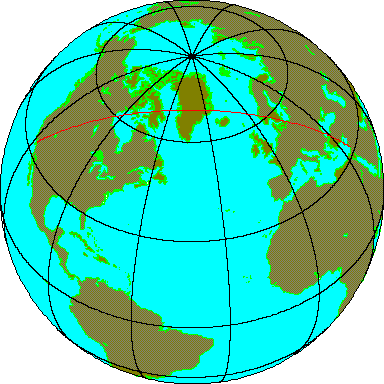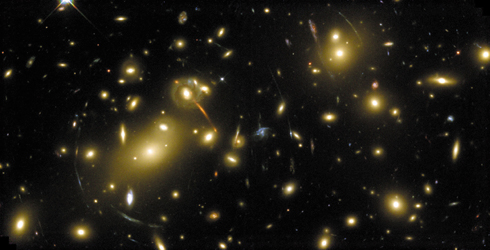- difference between special and general relativity
- axioms and Einstein
- The laws of physics are identical in all inertial frames.
- Light signals in vacuum are propagated rectilinearly, with the same speed c = 3 x 108 m/s , at all times, in all directions, in all inertial frames.
- Special relativity holds in any local region (spacetime is curved, but locally flat).
- Freely falling particles move along inertial paths (called timelike geodesics).
- Principle of Equivalence: it is not possible to do any experiment to distinguish whether you are under the influence of gravity, or constant acceleration. Or, forces produced by gravity are indistinguishable from the forces produced by acceleration.
- how fast is an airplane flying?
- points of view and paradoxes
- the Moon is up for some people, but not up for others -- "up" and "down" depend on where you are
- relativity at ordinary speeds
- if you drive down the road and pass someone standing at the side of the road, they seem to be moving and not you.
- from their perspective, of course, it is you that is moving.
- if they run in the same direction as you are driving, they appear to be moving more slowly than if they were standing still.
- This is relativity at ordinary speeds--called galilean relativity
- something different happens near the speed of light, however!
- fast clocks and time dilation
- consider a clock made of a laser beam and mirror.
- can show time dilation from simple triangle--if light always travels at speed c, the moving clock must tick more slowly
- fast meter sticks and length contraction
- use two clocks, one lying sideways (in the direction of motion) and one oriented as above
- can show that the length of the horizontal clock is shorter, for moving clocks
- moving things are shorter in their direction of motion
- events and spacetime
- the key to thinking about spacetime is to consider events
- things are not simultaneous in all frames
- relativity leads to several different "paradoxes"
- twin paradox -- extremal aging
- pole and barn paradox
- energy and momentum (increasing mass and adding velocities)
- one way to think of effect of increasing speed is that it increases mass
- you cannot accelerate a mass to the speed of light, because as you approach c, its mass approaches infinity, so it would take infinite energy to get to speed c. Only massless objects (e.g. photons, gravitons) can travel at the speed of light.
- this gives the concept of rest mass, where energy is E = moc2, but when moving, it is E = mc2 where m = gmo.
- addition of velocities is not like galilean addition. If you are traveling at 0.8c relative to me, and you fire a rocket at 0.4c, it seems it should go 1.2c relative to me. But in fact it will only go 1.2/1.32 c = 0.91c. So velocities add differently near the speed of light.
- experimental evidence for special relativity (muon decay)
- muons created in the upper atmosphere can be detected at the ground, even though they should decay before they can reach the ground.
- from our point of view--their clocks run slowly at near the speed of light, so they live long enough to reach the ground.
- from their point of view--their clocks run normally, but the ground is moving relative to them, so the distance to the ground seems much shorter.
- extension to accelerating frames--general relativity
- Einstein struggled for many years to extend relativity to accelerating frames
- the equivalence principle
- The breakthrough was when he realized that an accelerating frame and a gravitating frame should have the same physical laws--the equivalence principle. Principle of equivalence in General Relativity
- This leads to the bending of light by gravity. Since light (a photon) has no mass, it cannot experience a force in the same sense as a mass, so how can it bend?
- spacetime curvature and gravity
- Einstein realized that an answer could be that space itself is curved in the presence of a mass.
- Any object will follow an inertial path (a geodesic). Imagine flying from Los Angeles to Tel Aviv across the Atlantic. If you follow a line of latitude, you are actually following a curved path. If you take a straight path, it would look curved on a "map." This is due to the curvature of the Earth.
- no force of gravity, just spacetime curvature
- But if space is curved, it can completely replace "gravity."
- Puzzle of the "two masses" inertial mass and gravitational mass...can be explained.
- So what is the force of gravity. When things "fall" they follow their inertial paths in curved spacetime. If we "fall" with them, they will appear stationary to us. They only appear to fall relative to us because of the peculiar frame we are in--the ground is pushing us away from our inertial path. We are the ones who are accelerating, and for good reason--the Earth is pushing up on our feet.
- weird relativity effects in gravitational fields
- clocks in a "gravity well" run slower (remember we said that light suffers gravitational redshift--this is really time dilation due to spacetime curvature)
- distances near a "gravity well" appear shorter than they are. If you measure the circumference of an orbit to get a radius enclosed by the orbit, that radius is smaller than the true radius of the volume enclosed by the orbit. It is like a magic bag, with more volume inside than it appears.
- experimental evidence for general relativity (gps satellites, bending light)
- First evidence for general relativity was bending of starlight near the Sun, seen during a solar eclipse. The amount of bending was only about 1 arcsecond.
- Today, we can tell time and our position by using signals from GPS (Global Positioning System) satellites. The satellites have very accurate clocks on board, but they run more slowly due to their orbital speed around the Earth. Still, our clocks on Earth run more slowly due to the fact that we are deeper in the gravity well than the satellites. These two effects partially offset, but BOTH general and special relativity have to be taken into account, or GPS would never work!
Einstein advanced the following two axioms for Special Relativity:

